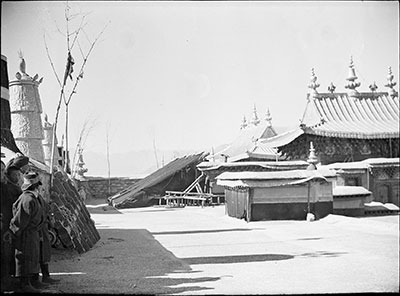
1998.131.311 (Film negative)


1998.131.311 (Film negative)

Frederick Spencer Chapman
Frederick Spencer Chapman
November 22nd 1936
Lhasa > Potala > Tombs of Dalai Lamas >
1998.131.311
85 x 111 mm
Negative film nitrate
Donated 1994
Faith Spencer Chapman
British Diplomatic Mission to Lhasa 1936-37
Frederick Spencer Chapman
C.18.15 [view film roll]
SC.T.2.311
In Negative - The number '15' has been scratched into the negative in the bottom right hand corner [MS 11/4/2005]
Technical Information - This image was taken with a quarter plate Zeiss Nixe film or film pack camera as the negative is quarter-plate sized. See Chapman Lhasa The Holy City, [London: Chatto & Windus, 1938] for a description of the still and cine cameras that Chapman used as Mission photographer [MS 25/2/2005]
Manual Catalogues - Caption in Chapman's hand-written list of negatives made whilst on the Mission to Lhasa, 1936-7 [See PRM Manuscripts Collection]: 'Tombs of D.L.’s L. to R.' [MS 18/03/2006]
Other Information - Related Images: Images 1998.131.311, 312, 313 & 314 form a panorama of the roof [MS 18/03/2006]
Other Information - Related Images: Images prefixed with 'C.18' comprise a group of negatives containing images of the mission personnel, the Dalai Lamas’ tombs and Potala. They were all taken on November 22nd on the day of the second official visit of the Mission party to the Potala. [MS 18/03/2006]
Other Information - Historical Background: The screen with the yak-hair blanket draped across, apparently protecting one side of the 13th Dalai Lama's tomb, may have been in place because of the painting work that was taking place around the newly built mausoleum at that time. Chapman describes this quite fully in his publication Lhasa the Holy City [London: Chatto & Windus 1938; reprinted London: Readers Union Ltd., 1940, p.180]: "On the upper story of the tomb, which surrounds the chorten like a balcony, some fifteen of the best Tibetan artists were at work on a series of thankas illustrating the life-story of the Dalai Lama. It was interesting to see them at work. They were obviously men of some standing, as each wore the long turquoise and gold ear-ring. They wore white shirts, indigo or purplish broadcloth robes, and black top-boots. They worked on fine canvas, which had been prepared and stiffened with white paint; this was stretched over a wooden frame about four feet high and two and a half feet wide, which they rested on their knees, as they sat cross-legged on the floor. The paints, made of stones and earths (many of them imported from India) ground up with oil, were in separate porcelain saucers. The brushes, of which each painter used several, appeared to be of hog's bristle. The work was extremely fine and they showed great accuracy and skill, though they all painted in the conventional manner so that it would have been difficult to pick out the work of individual artists. The Potala, considerably conventionalized, appeared in many of the paintings, also procession of monks, street scenes, and landscapes, as well as the usual Buddhas, curly clouds, and stiff formal flowers. As is usual with Tibetan pictures, every corner of the canvas was filled up. Each artist had his wooded teacup and tsamba bag beside him, and seemed to drink every few minutes". [MS 11/4/2005]
For Citation use:
The Tibet Album.
"Roof of Potala showing tombs of Dalai Lamas"
05 Dec. 2006. The Pitt Rivers Museum.
<http://tibet.prm.ox.ac.uk/photo_1998.131.311.html>.
For more information about photographic usage or to order prints, please visit the The Pitt Rivers Museum.
© The Pitt Rivers Museum